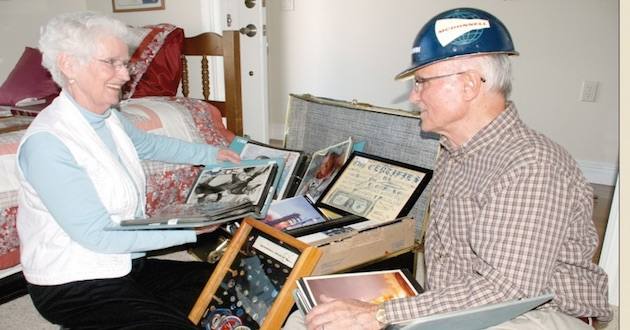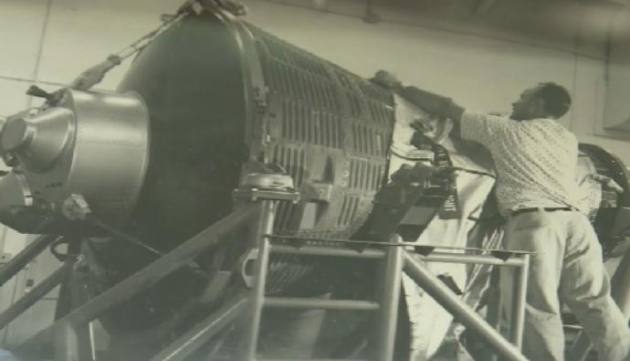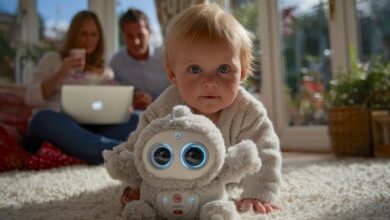Ozark, MO man central to spaceflight program

Although he never left the ground, an Ozark, Missouri man had a front row seat to the glorious history of American spaceflight.
While the astronauts got all the attention, thousands of technicians working behind the scenes made their flights possible and helped the United States beat out the Russians in the race to be the first superpower to put a man on the moon.
88 year-old George Baldwin is one of those unsung heroes in America’s story of spaceflight.
READ OUR MOVIE REVIEW OF “FIRST MAN”
Baldwin has been a long time member and Sunday School teacher at Ozark First Baptist Church. But what many people don’t know about him is that he played a role in one of mankind’s greatest technological achievements.
And if you go to the church’s library, there’s one copy of a book put together by Baldwin that offers interesting anecdotes and photos of his time working on one of the most important projects in our country’s history.
Despite getting a late start behind the Russians, America became the first country to put a man on the moon in 1969. But the struggle to get there started over a decade before that with the establishment of NASA, who signed on with St. Louis-based McDonnell-Douglas to build the capsules for their very first space missions, the Mercury and Gemini programs.
Baldwin had started as an engineer at McDonnell-Douglas in 1952 in the aircraft test division when he saw a bulletin that the company was getting involved in “astronautics” and were asking for volunteers.

Soon he was among a team of St. Louis engineers building space capsules that would launch an historic part of our nation’s history. Baldwin not only helped build the capsules, but would accompany them when they were transported by plane to Florida’s Cape Canaveral for testing and launch.
When asked of his first impressions when he started working on the newfangled spacecraft?
“They looked like a bunch of tin cans really,” he said with a laugh.
Back then the capsules had miles and miles of wires. There was no digital technology and the computers were crude and elementary compared to today.
“You got an i-phone?,” he asked. “Well that’s got 100 times more capability than the computer we had in the spacecraft.”
The conditions at the swampy Cape Canaveral were also primitive at the time as a rocket test once had to be scrubbed because the engineers couldn’t make it up the platform.
“This big alligator’s laying across the steps,” Baldwin recalled. “They threw rocks at him but he wasn’t gonna move. They had to call the conservation department to come get him out of there.”
And that wasn’t the only run-in with animals. While Baldwin became good friends with the human astronauts like Alan Shepherd, the first American in space, and John Glenn, the first to orbit the earth, the first astronaut he worked with was Ham, a chimp who proceeded the humans into space. Ham was trained by being awarded banana pills every time he pulled the right lever. But one time when he pulled the right lever and didn’t get his reward, things got nasty.
“He like to tore that thing up before we got him out of there,” Baldwin laughed about the tiny compartment that the chimp trained in with the levers. “He wanted his pill.”
Baldwin is proud of the fact that no astronauts lost their lives during his time building capsules. It wasn’t until Apollo 1’s fire on the launch pad that three astronauts lost their lives including Gus Grissom, who Baldwin counted as a friend.
“That was difficult,” Baldwin said. “Especially considering Gus was a good friend. And during our time we had a lot of things go wrong. It made you think that the same thing could have been on our shoulders had we had the same kind of problems.”
Baldwin was on a trip to Alaska when he finally saw the fruits of all his labor with the moon landing, but his reaction was tempered by the fact that “nobody in Alaska believed that (it really happened). They said it was Walt Disney.”
Today literally thousands of our every day products and advances in technology are due to the spaceflight program.
“Velcro for one thing. A lot of Velcro,” Baldwin said with a smile.
But George Baldwin is one to look forward, not backwards.
“I’d like to see us go to Mars.”
–KY3News







